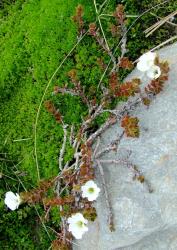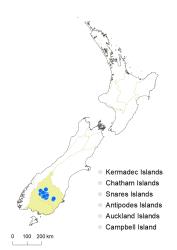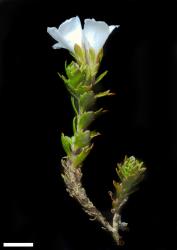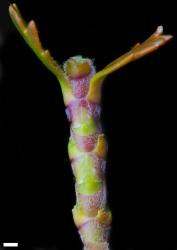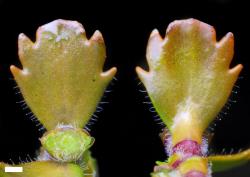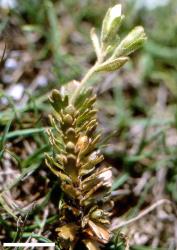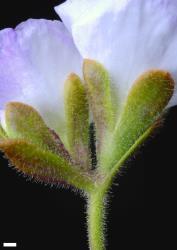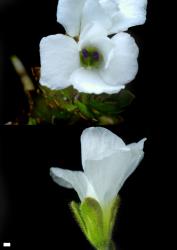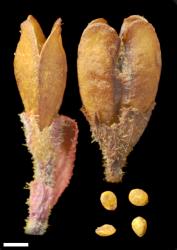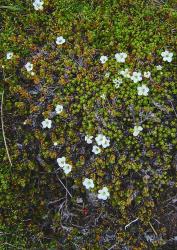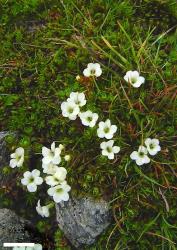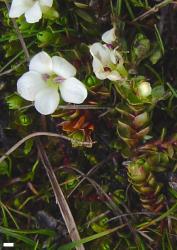- ≡ Parahebe trifida (Petrie) W.R.B.Oliv., Rec. Domin. Mus. 1: 230 (1944)
- ≡ Hebejeebie trifida (Petrie) Heads, Bot. Soc. Otago Newsl. 36: 11 (2003)
Low sprawling or creeping sub-shrub to 0.2 m tall. Stems prostrate, ascending at tips, eglandular-pubescent; hairs uniform. Leaf bud indistinct; leaves separating while very small, opposite-decussate to sub-distichous, erecto-patent. Lamina thin to sub-coriaceous, elliptic, obovate, oblong, oblanceolate, or spathulate, rarely sub-orbicular, 2–10 mm long, 1–7 mm wide, glossy green or bronze-green above and beneath; veins not evident; surfaces glabrous; margin sparsely glandular-ciliate, rarely some eglandular hairs as well, serrate, crenate or lobed; teeth or lobes in 1–3 pairs; apex obtuse, rounded, or sub-acute; base cuneate; petiole 1–2 mm long. Inflorescence a lateral raceme, 15–25 mm long; flowers crowded or distant, 2–3 or solitary and bibracteate; peduncle 2–10 mm long, all bisexual; bracts opposite or alternate, elliptic or obovate, >pedicels; pedicels sub-erect, 0.5–7.0 mm long, mixed glandular- and eglandular-hairy all around. Calyx lobes 4, rarely reduced 5th lobe present, obtuse to sub-acute, 4.0–5.5 mm long, equal, glandular-hairy with a few eglandular hairs. Corolla 15–20 mm diameter; tube white, rarely purplish, greenish-yellow at the base, 3–4 mm long, < calyx, glabrous; lobes 5, sometimes 6, white, rarely purplish, erecto-patent to recurved, unequal, elliptic to obovate or orbicular, 6–11 mm long, obtuse to rounded; nectar guides absent. Stamen filaments white or greenish, 2–3 mm long; anthers purple, sometimes magenta or pink. Style glabrous, 2.5–4.0 mm long. Capsule angustiseptate, emarginate, glabrous or with a few glandular hairs, 4.5–6.0 mm long, 2.5–3.5 mm at widest point. Seeds ellipsoid to obovoid, flattened, smooth, pale brown to brown, 0.8–1.2 mm long.
birleyi | spectabilis | trifida | densifolia | thomsonii | pulvinaris | chionohebe | ciliolata | |
|---|---|---|---|---|---|---|---|---|
Habit | lax sub-shrub | lax sub-shrub | lax sub-shrub | lax sub-shrub | cushion plant | cushion plant | cushion plant | cushion plant |
Stem hairs | eglandular & a few glandular, spreading | mixed glandular & eglandular, spreading | eglandular, retrorse | eglandular, retrorse | glabrous | glabrous | glabrous | glabrous |
Leaf size (mm) | 4.0–12 × 2.5–11 | 4.5–13 × 2.5–6.0 | 2–10 × 1–7 | 2–6.5 × 0.7–3 | 1.7–4.7 × 0.7–2.6 | 1.8–4.8 × 0.5–2 | 1.75–5 × 0.75–2.25 | 1.75–4.5 × 0.8–2.8 |
Leaf margins | deeply crenate to lobed | deeply crenate to lobed | shallowly toothed to lobed, rarely entire | usually entire, rarely 1–2 teeth or lobes | entire | entire | entire | entire |
Lamina | subcoriaceous, flat; margin not thickened, smooth | subcoriaceous, flat; margin not thickened, smooth | subcoriaceous, flat; margin not thickened, smooth | coriaceous, keeled, with thickened papillate margin | thin, flat; margin not thickened, smooth | thin, flat; margin not thickened, smooth | thin, flat; margin not thickened, smooth | thin, flat; margin not thickened, smooth |
Leaf hairs: adaxial | scattered eglandular | mixed eglandular & glandular | glabrous | glabrous | eglandular: in broad band across middle, occasionally scattered distally | eglandular appressed: scattered or in a central patch on distal half | absent | absent or isolated and scattered in distal ½ |
Leaf hairs: abaxial | scattered eglandular | mixed eglandular & glandular | glabrous | glabrous | glabrous, or stiff, eglandular, isolated distal hairs | glabrous or eglandular appressed scattered distally | absent or isolated in distal ½ | absent or isolated and scattered in distal ½ |
Leaf hairs: margin | eglandular-ciliate | mixed eglandular & glandular-ciliate | long glandular-ciliate | stiff eglandular-ciliate | ciliate in basal ⅔ with apical tuft | eglandular appressed: ciliate | absent or scattered cilia | ciliate throughout or in basal or distal half, usually with apical tuft |
Sexual system | cosexual | cosexual | cosexual | cosexual | dioecious | dioecious | dioecious | dioecious |
Inflorescence | 2–3 flowers, sometimes solitary bibracteolate | 2–3 flowers, sometimes solitary bibracteolate | 2–3 flowers, sometimes solitary bibracteolate | solitary bibracteolate | solitary bibracteolate | solitary bibracteolate | solitary bibracteolate | solitary bibracteolate |
Peduncle (mm) | 2–4 | 5–15 | 2–10 | 0 | 0 | 0 | 0 | 0 |
Pedicel (mm) | 0.3–1.5 | 2.5–5 | 0.5–7 | 0 | 0 | 0 | 0 | 0 |
Calyx lobes | 4 | 4 | 4 | 5 | 5 | 5 | 5 | 5 |
Corolla lobes | (4–)5(–6) | 4(–5) | 5(–6) | 5(–6) | 5 | 5 | 5 | 5 |
Corolla diameter (mm) | 7–10 | 18–25 | 15–20 | 7–16 | 2.5–5 | 2.5–6 | 1.5–4.1 | 2.1–6.5 |
Corolla shape | funnelform | funnelform | funnelform | funnelform | rotate | rotate | rotate | rotate |
Capsule size (mm) | 3–4 × 3–4 | 4–5 × 4–5 | 4.5–6 × 2.5–3 | 2.7–5 × 1.7–4.25 | 1.5–3 × 1–2 | 1–3 × 1.2–2.7 | 1.9–2.5 × 1.5–1.9 | 2.5–3.5 × 1.4–3.1 |
Capsule hairs | glabrous | mixed glandular & eglandular-hairy at apex | glandular-ciliate, sometimes glabrous | glabrous | glabrous to densely hairy at apex | eglandular-hairy, especially at apex | absent | absent or apical |
South Island: Otago (Hector Mountains, Old Man Range, Garvie Mountains, Umbrella Mountains, Lammermoor Range), Southland (Cecil Peak).
Alpine seepages and flushes of melt-water associated with summer snow-banks, edges of water races, boggy ground. Recorded elevations range from 1070 to 1840 m.
Where the ranges of V. trifida and V. chionohebe meet (Garvie Mountains, Old Man Range) hybrids between them are quite frequent (Garnock-Jones & Lloyd 2004). Such plants are lax, softly woody sub-shrubs to about 5 cm tall; leaves entire, margin ciliate and glandular-ciliate; flowers solitary, axillary, bibracteate; pedicel c. 0.8 mm long; calyx 3-nerved with a few cilia, both glandular and eglandular, 3 mm long; calyx lobes 5, regular or 1 smaller, obovate-elliptic, with glandular and eglandular cilia (glandular distally); corolla rotate, 7 mm diameter, tube c. 2.5 mm (< calyx).
Flowers: December–February: fruits: January–April (and probably persisting longer).
2n = 42 (Hair 1970).
Veronica trifida is classified in V. subg. Pseudoveronica sect. Hebe and informally in the “snow hebe” group (Albach & Meudt 2010).
Analysis of ITS sequence data indicates V. trifida is sister species to V. densifolia, and its next nearest relative is V. spectabilis (and probably V. birleyi). These species are morphologically similar in growth form, leaf lobing (when present), inflorescences, five- to six-lobed corollas, and short stamens and styles. The ITS tree topology suggests this group is sister to a large clade of shrubby hebes, sun hebes and speedwell hebes, but field observations and phylogenetic analysis of chloroplast DNA indicate they hybridise with the cushion snow hebes, and that process probably includes chloroplast exchange. Thus cpDNA sequences of V. densifolia and V. spectabilis cluster with those of V. pulvinaris and V. thomsonii, whereas those of V. trifida cluster with V. ciliolata, V. chionohebe (with which hybrids are observed in the field), and another accession of V. thomsonii.
The leaves often dry black in herbarium specimens, but retain their glossy surface. The margins of the corolla lobes are finely fimbriate or erose.
The earlier V. trifida Gilibert, Flora Lithuanica 1, 121 (1785), based on a different type, is not a legitimate name because the work it is published in is listed in Opera Utique Oppressa (http://www.bgbm.org/iapt/nomenclature/code/saintlouis/0116AppendixV.htm).



